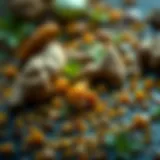Understanding Dietary Needs of Ducks and Geese
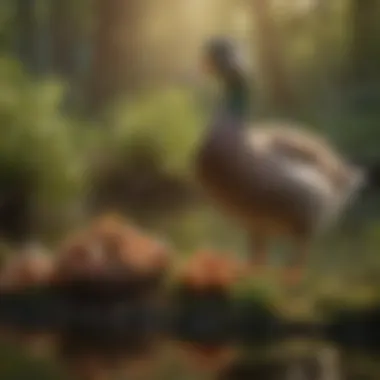

Intro
Ducks and geese are an integral part of many ecosystems, often recognized for their aesthetic qualities and significance in local biodiversity. Their dietary habits directly influence their health and, by extension, the environments they inhabit. This article provides a detailed exploration of the dietary needs of these waterfowl. Through an analysis of their natural feeding behavior, suitable food options, and potential dietary restrictions, a deeper understanding emerges not only for caretakers and enthusiasts but also for conservationists and students concerned with ecological advice.
Overview of the Topic
Understanding the dietary needs of ducks and geese is crucial for several reasons. First, these birds play vital roles in the ecosystems they occupy. They assist with seed dispersal and wetlands maintenance. With increasing urbanization and habitat destruction, knowledge about their nutritional requirements becomes essential for both sustaining population numbers and preserving biodiversity.
Ducks and geese are herbivores, primarily consuming plant material, grains, and seeds. However, their diets can vary based on season, geographical location, and microhabitats they occupy. Recognizing their natural preferences contributes to the formulation of feeding strategies that align with their ecological needs.
Background Information on the Significance of the Topic
The global population of ducks and geese is subject to fluctuations influenced by various environmental factors. Their nutrition influences their health, reproduction, and migratory success. A lack of understanding regarding their dietary preferences may result in inadequate feeding practices and could ultimately harm their populations. Furthermore, responsible feeding strategies also benefit local ecosystems, reinforcing the connection between human actions and wildlife preservation.
With heightened awareness around wildlife conservation, this guide aims to empower individuals with knowledge to support the well-being of these species. Enabling proper diets not only enhances individual bird health but also promotes overall ecosystem health. Therefore, this article’s insights serve as a valuable resource for anyone vested in ecological stewardship.
Preamble to Ducks and Geese
The understanding of ducks and geese serves multiple significant purposes. As integral components of various ecosystems, waterfowl ensures ecological balance. This article aims to shed light on the dietary needs and natural behaviors of these birds, thus promoting their survival and habitat preservation.
Ducks and geese are not only captivating due to their unique characteristics but they also play crucial roles in their environments. They contribute to the food web, interact with plant life, and impact aquatic ecosystems. Recognizing these contributions is essential for conservation efforts. This guide will provide insights essential for anyone interested in the care and evolution of these species.
The Ecological Role of Waterfowl
Waterfowl, including ducks and geese, fulfill fundamental roles in the ecology of their habitats. They act as foragers, grazing on vegetation and aiding in seed dispersion. This behavior strengthens local flora, thereby indirectly providing food and shelter for countless organisms.
- Their droppings fertilize soil, improving plant growth.
- They provide an important food source for predators such as eagles and foxes.
- By maintaining healthy plant growth, they support the hydrographic complex.
In wetlands, these birds help regulate water systems through their feeding habits by facilitating the breakdown of organic matter. This enrichment promotes clean water sources, critical for both human and ecological health. Thus, waterfowl take on more than a mere survival role; they forge ecological connections throughout their ecosystems.
Species Overview
Ducks and geese belong to several distinct species, each with specific adaptive traits and behaviors suited to their environments. Key species include the mallard, the northern pintail, and theCanada goose.
- Ducks: Often are smaller and possess a more varied diet, ranging from aquatic plants to invertebrates. They are known for their adaptability, existing in diverse habitats such as ponds, rivers, and marshes.
- Geese: Generally larger than ducks and mostly herbivorous, geese often graze on grasses and grains found in northern latitudes. Their migratory patterns can cover extensive distances, showcasing their adaptability to changing environments.
Diversity in waterfowl comes with a variety of teaching moments for those looking to study avian life. From understanding feeding behaviors to migration trends, knowledge of the various species enrichens our appreciation of these animals.
Natural Diets of Ducks and Geese
Understanding the natural diets of ducks and geese is crucial for their health and overall well-being. These birds have evolved to consume a variety of foods that provide the necessary nutrients for their physical and developmental needs. By replicating their natural diets with suitable feed, caregivers can support their growth, reproductive success, and vitality.
Typical Feeding Habits
Ducks and geese exhibit diverse feeding behaviors, often influenced by their environment and species. They are mostly herbivores, but omnivorous tendencies are evident. Foraging is a natural activity, and both species take advantage of available food resources in wetlands, forests, and agricultural lands.
This adaptation allows them to utilize diverse food sources, ensuring high nutritional intake. They can graze on land and dabble or dive for food in water, showcasing their versatile adaptations to various environments.
Preferred Natural Food Sources
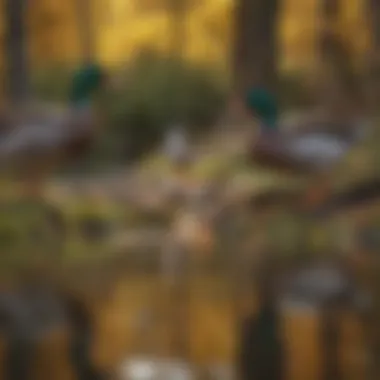

Natural food sources play a vital role in providing ducks and geese with balanced nutrition. Their key sources include aquatics plants, seeds and grains, and invertebrates.
Aquatic Plants
Aquatic plants are integral to the diet of these birds. They provide essential nutrients and are easy to access, especially in wetland areas. Key characteristics of aquatic plants include high carbohydrate and protein levels, making them valuable for energy-rich diets.
Their ecological roles promote healthy environments, participating in nutrient cycling. However, one challenge with aquatic plants is seasonal availability. Relying solely on these foods may lead to nutritional deficiencies when they are scarce.
Seeds and Grains
Seeds and grains serve as another critical component of the diet for ducks and geese. These materials are often rich in energy and fats. The popularity of seeds and grains stems from their widespread availability in natural and farmed landscapes.
Key characteristics include their ability to store energy, making them vital during migration and winter months when access to other foods may be limited. However, over-reliance should be avoided, as they provide limited nutritional variety when compared to other food sources.
Invertebrates
Invertebrates like worms, snails, and insects complete the diet of ducks and geese, adding protein crucial for growth and breeding. Their feeding on invertebrates showcases adaptability, leveraging what is available in their environment.
Invertebrates' key benefits include their high protein content and mineral supply, addressing the needs of adult birds and chicks. However, their availability can fluctuate due to environmental conditions or seasonal changes, leading to inconsistent diet quality.
Evaluating Food Choices
Evaluating food choices is a critical aspect of caring for ducks and geese, particularly those in domestic settings. The right diet not only supports the overall health of waterfowl but also plays a vital role in their behavior and reproductive success. It is paramount to recognize both the types of foods that can significantly foster their wellbeing as well as those that might pose potential health risks. Making informed dietary decisions for ducks and geese can mitigate issues that arise from poor nutrition depending on different contexts, such as the habitat, age of the birds, and whether they are wild or domestic.
Appropriate Foods for Domestic Ducks and Geese
Feeding ducks and geese a varied and balanced diet is essential. Domestic waterfowl primarily thrive on formulated pellets designed for their specific dietary requirements. High-quality commercial feeds provide the necessary minerals and vitamins. Additionally, numerous supplementary foods can enhance their diet. Here are key options:
- Leafy greens: Kale, spinach, and lettuce can offer necessary nutrients for ducks and geese.
- Grains: Cracked corn and oats can complement their diet by providing carbohydrates for energy.
- Vegetables: Peas, carrots, and squash can be effective for wellness.
- Aquatic plants: Water lilies and similar plants are natural forages that stimulate natural feeding tendencies.
Consider mixing several food types to keep their diet consistent with their wild adaptations. A balanced combination enriches their feeding experience both nutritionally and physically.
Foods to Avoid
Certain foods can be harmful or even toxic for ducks and geese. Impaired digestion and health issues can arise from inappropriate feeding choices. Key items to avoid include:
- Bread: This is often seen as a popular choice, but it can lead to nutritional deficiencies and other health eventualities. Bread does not provide necessary nutrients.
- Processed foods: These can contain high salt levels and preservatives harmful to waterfowl.
- Avocado: The fruit contains persin, which can be toxic.
- Dry foods: Pellets that lack moisture can obstruct their digestive system.
Processing Avian Needs requires stricter attention. Feeding birds more treats than complete meals can splendidly disrupt health.
Appropriate evaluation of food choices not only contributes to immediate health advantages but also promotes long-term behavioral stability in ducks and geese, especially in domestic environments.
Selecting the right foods for ducks and geese should involve teocu(your creativity) in examining alternatives. Proper attentiveness to food selection leads to both commercial and home-prepared opportunities fruitful in diverse dietary needs.
Supplementing Natural Diets
Supplementing the natural diets of ducks and geese is a critical aspect of ensuring their health and longevity. While these birds have a variety of natural food sources in their ecosystems, supplementation can offer balance and additional nutrients, particularly in environments where food scarcity might occur. Recognizing the right types and proportions of supplements enhances nutritional intake while minimizing health risks associated with dietary shortcomings.
Commercial Feeds
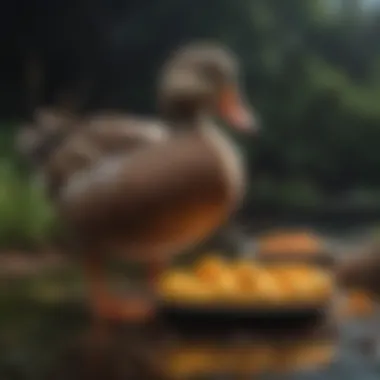

Commercial feeds designed specifically for ducks and geese provide many benefits. These ready-made feeds ensure a balanced blend of proteins, fats, and essential vitamins and minerals necessary for maintaining optimal growth and health. Common ingredients in these feeds may include corn, wheat, peas, and formulated vitamins. Choosing high-quality commercial feeds helps community members feed backyard flocks while minimizing nutritional deficiencies.
Opt for feeds labeled as suitable for the specific species you are raising, either ducks or geese. This is crucial for achieving a well-rounded diet tailored to their needs.
There are also specialized feeds for various life stages, such as starter, grower, and maintenance formulas. For instance:
- Starter feeds are crucial for young birds, containing higher protein levels to support rapid growth.
- Grower feeds help with gradual growth and developing body strength.
- Maintenance feeds keep adults healthy without promoting excessive growth.
Supplements can also be mixed in, such as calcium sources and grit for digestive health. Remember to check ingredients for non-GMO or organic options if sustainability is a concern when selecting commercial feeds.
Homemade Options
For those looking for a more hands-on approach to feed supplementation, homemade options can be an effective way to ensure dietary needs are met while controlling ingredients. Common homemade ingredients include grains, vegetable scraps, and even certain types of fruits. Ducks and geese often enjoy items such as crushed vegetables, dark leafy greens like kale or spinach, and cooked rice. These foods can provide essential vitamins while adding variety to their diet.
When preparing homemade meals, it is crucial to maintain balance and avoid harmful substances, including:
- Salt can lead to dehydration and kidney issues.
- Avocado contains persin, which is toxic for birds.
- Uncooked beans, higher in lectins, could be harmful.
Incorporating these homemade alternatives not only supports the bird's health but also inspires responsible feeding practices by minimizing waste. Community members can engage synergistically by exchanging healthy scraps or resources among fellow duck and goose keepers, creating a sustainable feeding ecosystem.
In summary, supplemental feeding—both through commercial feeds and homemade options—plays an essential role in enhancing the diets of ducks and geese. They provide a well-rounded nutritional profile, cover gaps, and promote responsible practices that resonate with conservation and concern for the birds' overall health.
Feeding Practices and Guidelines
Feeding practices for ducks and geese play a crucial role in ensuring their health and well-being. A well-planned feeding regimen helps improve growth, reproduction, and overall vitality in both domestic and wild populations. Adhering to guidelines can lead to optimal nourishment, relieves any potential stress on the birds, and minimizes negative environmental impact. Citizens participating in feeding also aid conservation efforts by fostering healthier populations while reducing the risk of diseases.
Best Practices for Feeding
Feeding ducks and geese should be approached with care and knowledge. Here are some best practices to implement:
- Choose Appropriate Foods: Birds thrive on species-specific diets. Aquatic plants, crushed grains, and commercial feed, specifically designed for waterfowl, boast nutritional balance.
- Feed in Moderation: Portion control is necessary to prevent overdependence. Distributing food that is easily consumed avoids spills, which might lead to attracting pests.
- Enjoy Natural Behaviors:
Observe their instincts by allowing for natural foraging. Scattered feed encourages them to move, stimulates exercise, and can aid in a more balanced diet.
Assessments should entail specific nutrients, also focusing on seasonal variations in needed sustenance.
Environmental Considerations
Environmental impacts of feeding should not be overlooked. Awareness of local ecosystems can guide better practices. Here are some considerations:
- Avoid Feeding Near Water Sources: Buildup of uneaten food can pollute the water, leading to harmful algal blooms and detrimental effects on local flora and fauna.
- Dispose of Leftovers Properly:
Leftover food should be cleared efficiently. This practice will deter pests and protect garbage spots often attractive to rodents. - Understand Migration and Food Sources:
Timing of feeding activities can either enhance or inhibit local populations. Supporting their natural rhythms respects their migration cycles and helps conserve energy resources.
Often, caring individuals overlook broader ecological implications of feeding practices affecting wild populations.
Effects of Overfeeding
Overfeeding can be incredibly detrimental to ducks and geese. Possible consequences include:
- Nutritional Imbalances:
Excessive feeding can lead birds to develop dependency on specific foods, sidelining essential nutrients found in forage. - Weight Issues and Health Risks:
Obesity can drain their overall energy, impair mobility, and lead to health ailments, including heart issues. - Site Dependency: An overemphasis on artificial feeding may deter natural foraging desires. This dependency dismantles an awareness vital for species survival.
Maintaining a disciplined approach towards feeding allows for nurturing healthy populations while respecting their natural ecosystems.
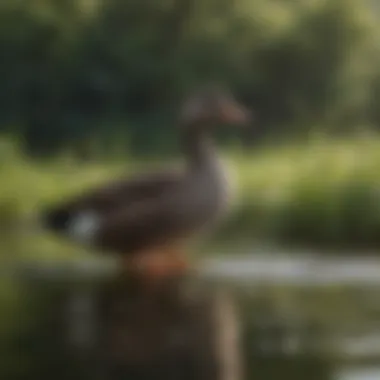

Health Implications of Diet
The dietary patterns of ducks and geese significantly influence their overall health. As such, it is crucial to understand the relationship between nutrition and the well-being of these birds in both captive and wild settings. A well-balanced diet not only supports normal growth and development but also helps in preventing potential health issues. When discussing this aspect, we should acknowledge the specific dietary needs of waterfowl to ensure they thrive and flourish both in natural settings and in agricultural systems.
Nutritional Deficiencies
Nutritional deficiencies can lead to serious health problems for ducks and geese. A lack of essential nutrients increases vulnerability to diseases and lowers reproductive success. Common deficiencies include vitamins A, D, E, and K, as well as minerals such as calcium and phosphorus. A precise understanding of these nutrients is critical. Here are a few important points to consider:
- Vitamin A is crucial for good vision and immune health. Insufficient vitamin A can cause poor vision, which may lead to accidents and reduced foraging efficiency.
- Vitamin D is integral for calcium absorption and skeletal health. Birds that are deficient may experience weak bones and deformities.
- Vitamin E assists in cellular function and reproduction. Its deficiency might result in breeding failures or poor hatchability.
- Calcium and phosphorus are needed for strong bones and eggshell formation. A higher division of responsibility must be placed on getting enough of these elements.
Therefore, any diet offered should include a good balance of these vital nutrients to avoid problems. Monitoring and correctly managing nutrition plays a vital part in a healthy flock.
Common Health Issues
The importance of a balanced diet extends to understanding common health issues that arise from poor nutrition among ducks and geese. These issues can be broad and varying, but many problems signify underlying dietary failures. Let’s explore notable health concerns seen often:
- Metabolic Disorder: This condition emerges from overfeeding, often from energy-dense diets leading to overweight birds, which can induce various related issues, including heart problems.
- Pour Growth and Development: Birds with insufficient nutritional variety may exhibit slow growth rates and lethargic behavior, affecting their overall vitality.
- Dermatitis: A lack of specific fatty acids can lead to skin wounds and irritations, thus impacting feather quality.
- Immunosuppression: Birds with nutritional deficits can find themselves less capable of fighting infections, leading to outbreaks of illnesses.
- Decreased Reproductive Rates: A poorly balanced diet directly impacts breeding efficiency, leading to failed reproduction in mating pairs.
Preemptively addressing these issues through education focusing on proper feeding is very important for both animal welfare and conservation efforts. Providing responsible care involves regularly reassessing the birds’ diet to adapt to any specific health signs observed.
Proper nutrition is not only a matter of promoting well-being but also a fundamental aspect of conservation, facilitating the stability of duck and goose populations.
Conservation and Ethical Feeding Practices
Conservation and ethical feeding practices are essential components in understanding the dietary needs of ducks and geese. Recognizing the delicate balance of ecosystems where these birds thrive is critical. Ethical feeding can enhance the well-being of resident populations while minimizing any adverse effects on their wild counterparts. Proper feeding can create a healthy environment for these waterfowl, necessitating knowledge about what to feed and how to feed it responsibly.
The Impact of Feeding on Wild Populations
Feeding ducks and geese, particularly in urban areas, often leads to unintended consequences for wild populations. When people regularly feed these birds unnatural foods like bread, they can disrupt their natural foraging behavior. This can cause them to become overly dependent on human-provided food.
- Artificial diets weaken survival skills. Ducks and geese raised on a diet that does not reflect their natural intake may struggle during migration or when sources dwindle during winter.
- Overcrowding can occur. Establishing feeding sites encourages excessive congregations, leading to high competition for food, which can contribute to territorial disputes.
- Disease transmission risk rises. Large groups interacting closely can facilitate disease spread, posing a threat not only to waterfowl but also to local ecosystems. Animals, like rodents, may also be drawn in when traditional feeding occurs, potentially causing further issues.
It is crucial to promote a balanced approach to feeding that aligns with the birds' natural diets.
"Educational outreach on responsible feeding behaviors can significantly reduce pressure on wild populations."
Community Involvement and Education
Involving the community provides a robust framework for successful conservation efforts. Educating the public about the dietary needs of ducks and geese helps mitigate harmful feeding practices. Many individuals can mistakenly believe that providing an excess of food, or feeding what seems appealing, supports local wildlife.
- Workshops and seminars on waterfowl biology can improve understanding about these birds’ nutritional needs, emphasizing natural food sources.
- Community programs can engage residents to participate in bird observation and monitoring, enhancing their interest in helping safeguard their local ecosystems.
- Social media campaigns leveraging platforms like Reddit and Facebook can spread awareness about ethical feeding choices. The accessibility of these platforms allows a broader audience to connect.
In summary, conservation and ethical feeding practices offer critical values in addressing the dietary needs of ducks and geese. It encourages a sustainable approach that protects both bud populations and their natural habitats.
Ending
In this article, understanding the dietary needs of ducks and geese emerges as a pivotal theme. Their well-being directly correlates with responsible feeding practices and overall ecosystem health. By grasping the specific nutritional requirements these birds entail, individuals can support their growth and vitality.
Significant Factors:
- The natural diets source understanding allows for a more tailored approach in commercial settings and from private owners.
- Choice of habitat must consider adequate food sources to uphold the breeding population. This aids in fostering sustainable populations and preserving their ecological contributions.
Incorporating ethical feeding practices influences wild populations positively. By developing informed feeding habits, one can actively participate in conservation efforts. Further education not only benefits the individual feeders but also the communities where feeding takes place. Ensuring that ducks and geese receive suitable nourishment aids in preventing nutritional deficiencies and related health issues.
“An informed feeder enhances the ecological balance and supports both pet and wild waterfowl alike.”
In summary, synthesizing the information provided establishes a comprehensive overview of what constitutes a balanced diet for these birds. Thus, informed choices lead to healthier ducks and geese, supporting conservation measures through deliberate and educated practices. Barlowing this knowledge not only deepens the appreciation for waterfowl but aligns the act of feeding with conservation goals, creating a more balanced co-existence between humans and these important species.
